BTEC ND Applied Science Unit 14: Heat Transfer Mechanisms Report
VerifiedAdded on 2021/04/17
|9
|1890
|83
Report
AI Summary
This report, prepared for a BTEC ND Certificate in Applied Science at Westminster Kingsway College, examines heat transfer mechanisms including conduction, convection, and radiation. It explains how these processes contribute to heat loss in homes and details methods to minimize such losses, such as insulation and double glazing. The report further explores the calculation of energy flow using industrial examples with varying thermal conductivities and temperature gradients, addressing the U-value of building materials. It differentiates between heat transfer mechanisms in solids, liquids, and gases, considering molecular motion, bulk motion, and surface properties in industrial processes, ultimately aiming to provide scientific evidence for 'green' home improvements. The report includes calculations, explanations, and analysis of different scenarios related to heat transfer, with references to various online resources to support the findings.
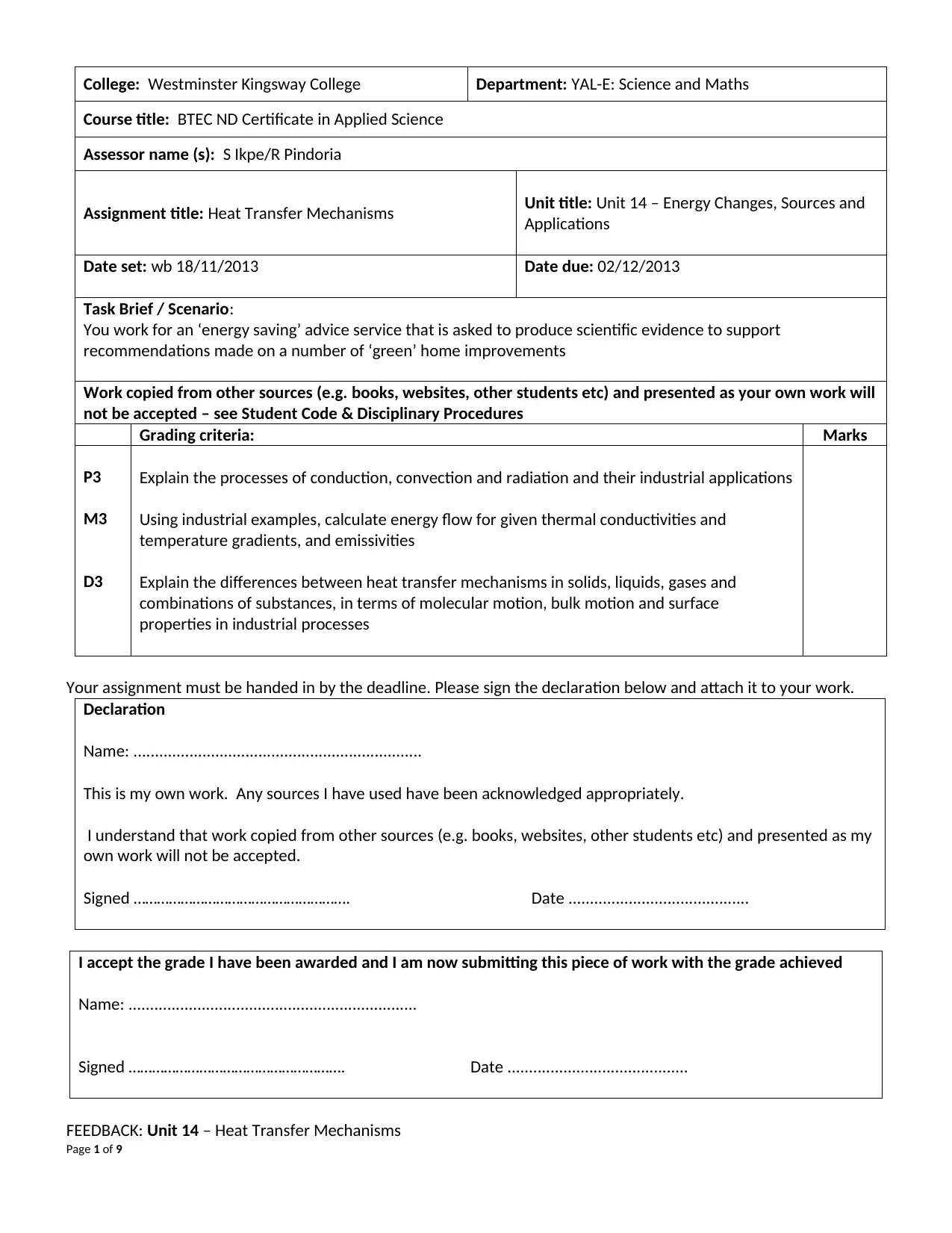
College: Westminster Kingsway College Department: YAL-E: Science and Maths
Course title: BTEC ND Certificate in Applied Science
Assessor name (s): S Ikpe/R Pindoria
Assignment title: Heat Transfer Mechanisms Unit title: Unit 14 – Energy Changes, Sources and
Applications
Date set: wb 18/11/2013 Date due: 02/12/2013
Task Brief / Scenario:
You work for an ‘energy saving’ advice service that is asked to produce scientific evidence to support
recommendations made on a number of ‘green’ home improvements
Work copied from other sources (e.g. books, websites, other students etc) and presented as your own work will
not be accepted – see Student Code & Disciplinary Procedures
Grading criteria: Marks
P3
M3
D3
Explain the processes of conduction, convection and radiation and their industrial applications
Using industrial examples, calculate energy flow for given thermal conductivities and
temperature gradients, and emissivities
Explain the differences between heat transfer mechanisms in solids, liquids, gases and
combinations of substances, in terms of molecular motion, bulk motion and surface
properties in industrial processes
Your assignment must be handed in by the deadline. Please sign the declaration below and attach it to your work.
Declaration
Name: ...................................................................
This is my own work. Any sources I have used have been acknowledged appropriately.
I understand that work copied from other sources (e.g. books, websites, other students etc) and presented as my
own work will not be accepted.
Signed ………………………………………………. Date ..........................................
I accept the grade I have been awarded and I am now submitting this piece of work with the grade achieved
Name: ...................................................................
Signed ………………………………………………. Date ..........................................
FEEDBACK: Unit 14 – Heat Transfer Mechanisms
Page 1 of 9
Course title: BTEC ND Certificate in Applied Science
Assessor name (s): S Ikpe/R Pindoria
Assignment title: Heat Transfer Mechanisms Unit title: Unit 14 – Energy Changes, Sources and
Applications
Date set: wb 18/11/2013 Date due: 02/12/2013
Task Brief / Scenario:
You work for an ‘energy saving’ advice service that is asked to produce scientific evidence to support
recommendations made on a number of ‘green’ home improvements
Work copied from other sources (e.g. books, websites, other students etc) and presented as your own work will
not be accepted – see Student Code & Disciplinary Procedures
Grading criteria: Marks
P3
M3
D3
Explain the processes of conduction, convection and radiation and their industrial applications
Using industrial examples, calculate energy flow for given thermal conductivities and
temperature gradients, and emissivities
Explain the differences between heat transfer mechanisms in solids, liquids, gases and
combinations of substances, in terms of molecular motion, bulk motion and surface
properties in industrial processes
Your assignment must be handed in by the deadline. Please sign the declaration below and attach it to your work.
Declaration
Name: ...................................................................
This is my own work. Any sources I have used have been acknowledged appropriately.
I understand that work copied from other sources (e.g. books, websites, other students etc) and presented as my
own work will not be accepted.
Signed ………………………………………………. Date ..........................................
I accept the grade I have been awarded and I am now submitting this piece of work with the grade achieved
Name: ...................................................................
Signed ………………………………………………. Date ..........................................
FEEDBACK: Unit 14 – Heat Transfer Mechanisms
Page 1 of 9
Paraphrase This Document
Need a fresh take? Get an instant paraphrase of this document with our AI Paraphraser
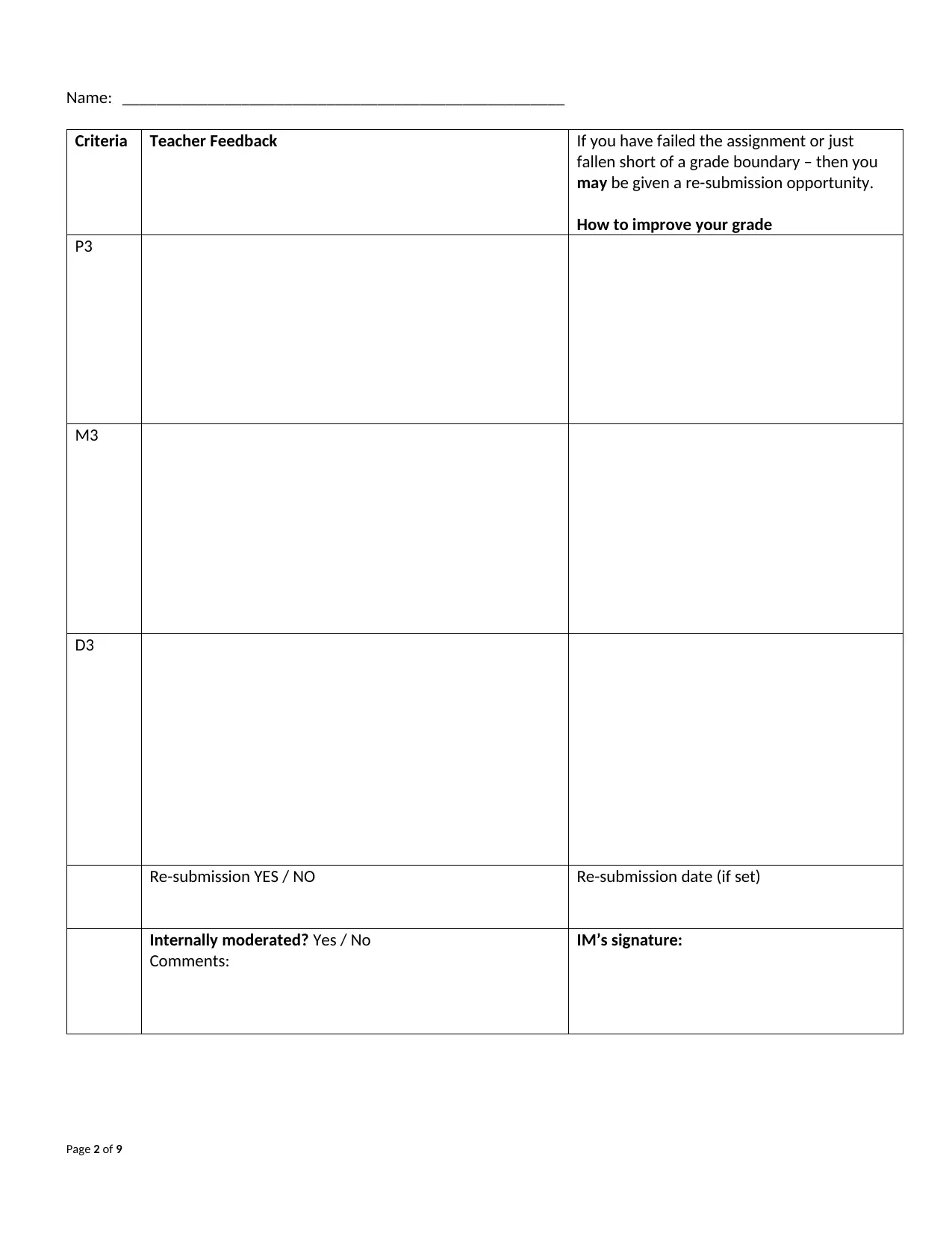
Name: ____________________________________________________
Criteria Teacher Feedback If you have failed the assignment or just
fallen short of a grade boundary – then you
may be given a re-submission opportunity.
How to improve your grade
P3
M3
D3
Re-submission YES / NO Re-submission date (if set)
Internally moderated? Yes / No
Comments:
IM’s signature:
Page 2 of 9
Criteria Teacher Feedback If you have failed the assignment or just
fallen short of a grade boundary – then you
may be given a re-submission opportunity.
How to improve your grade
P3
M3
D3
Re-submission YES / NO Re-submission date (if set)
Internally moderated? Yes / No
Comments:
IM’s signature:
Page 2 of 9
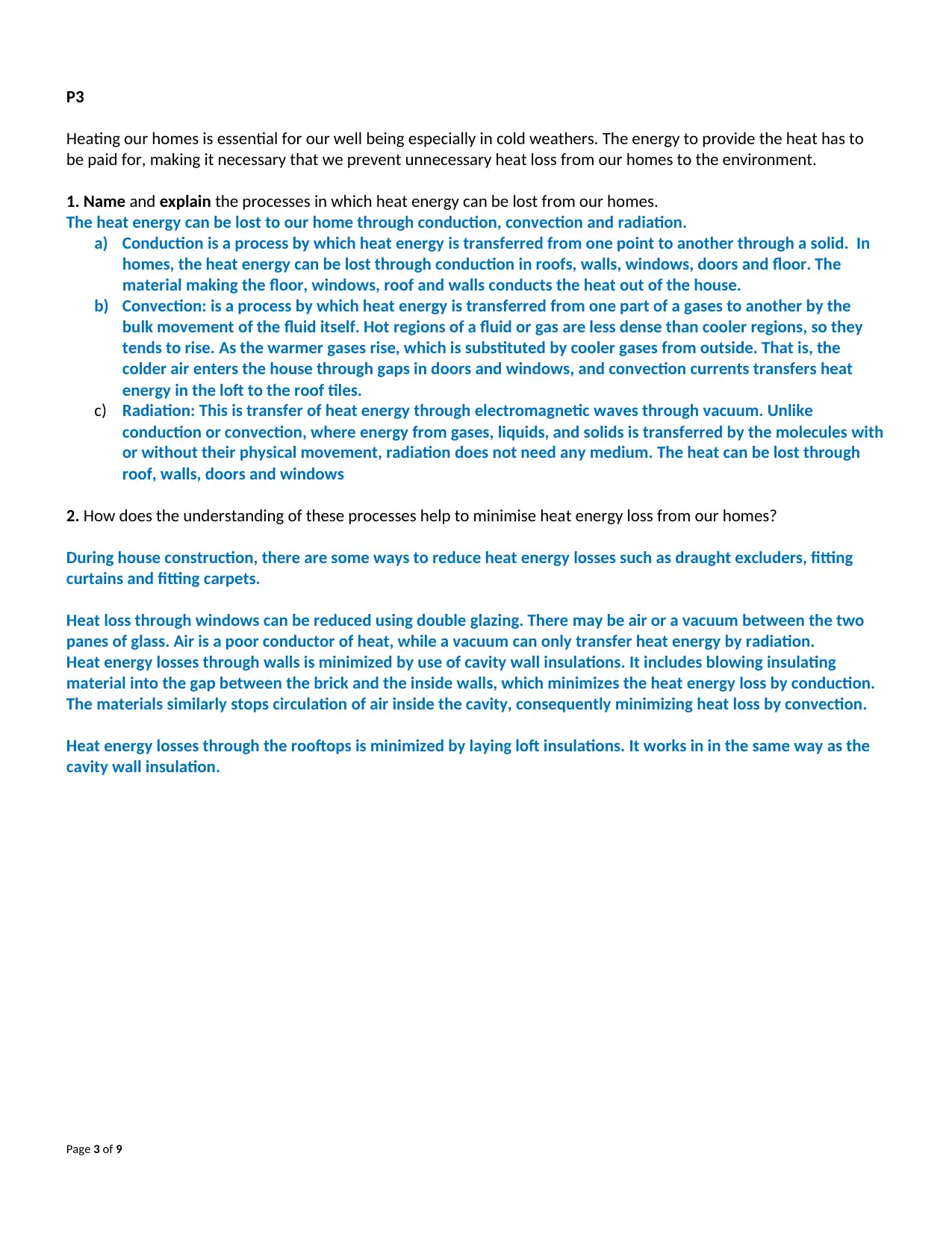
P3
Heating our homes is essential for our well being especially in cold weathers. The energy to provide the heat has to
be paid for, making it necessary that we prevent unnecessary heat loss from our homes to the environment.
1. Name and explain the processes in which heat energy can be lost from our homes.
The heat energy can be lost to our home through conduction, convection and radiation.
a) Conduction is a process by which heat energy is transferred from one point to another through a solid. In
homes, the heat energy can be lost through conduction in roofs, walls, windows, doors and floor. The
material making the floor, windows, roof and walls conducts the heat out of the house.
b) Convection: is a process by which heat energy is transferred from one part of a gases to another by the
bulk movement of the fluid itself. Hot regions of a fluid or gas are less dense than cooler regions, so they
tends to rise. As the warmer gases rise, which is substituted by cooler gases from outside. That is, the
colder air enters the house through gaps in doors and windows, and convection currents transfers heat
energy in the loft to the roof tiles.
c) Radiation: This is transfer of heat energy through electromagnetic waves through vacuum. Unlike
conduction or convection, where energy from gases, liquids, and solids is transferred by the molecules with
or without their physical movement, radiation does not need any medium. The heat can be lost through
roof, walls, doors and windows
2. How does the understanding of these processes help to minimise heat energy loss from our homes?
During house construction, there are some ways to reduce heat energy losses such as draught excluders, fitting
curtains and fitting carpets.
Heat loss through windows can be reduced using double glazing. There may be air or a vacuum between the two
panes of glass. Air is a poor conductor of heat, while a vacuum can only transfer heat energy by radiation.
Heat energy losses through walls is minimized by use of cavity wall insulations. It includes blowing insulating
material into the gap between the brick and the inside walls, which minimizes the heat energy loss by conduction.
The materials similarly stops circulation of air inside the cavity, consequently minimizing heat loss by convection.
Heat energy losses through the rooftops is minimized by laying loft insulations. It works in in the same way as the
cavity wall insulation.
Page 3 of 9
Heating our homes is essential for our well being especially in cold weathers. The energy to provide the heat has to
be paid for, making it necessary that we prevent unnecessary heat loss from our homes to the environment.
1. Name and explain the processes in which heat energy can be lost from our homes.
The heat energy can be lost to our home through conduction, convection and radiation.
a) Conduction is a process by which heat energy is transferred from one point to another through a solid. In
homes, the heat energy can be lost through conduction in roofs, walls, windows, doors and floor. The
material making the floor, windows, roof and walls conducts the heat out of the house.
b) Convection: is a process by which heat energy is transferred from one part of a gases to another by the
bulk movement of the fluid itself. Hot regions of a fluid or gas are less dense than cooler regions, so they
tends to rise. As the warmer gases rise, which is substituted by cooler gases from outside. That is, the
colder air enters the house through gaps in doors and windows, and convection currents transfers heat
energy in the loft to the roof tiles.
c) Radiation: This is transfer of heat energy through electromagnetic waves through vacuum. Unlike
conduction or convection, where energy from gases, liquids, and solids is transferred by the molecules with
or without their physical movement, radiation does not need any medium. The heat can be lost through
roof, walls, doors and windows
2. How does the understanding of these processes help to minimise heat energy loss from our homes?
During house construction, there are some ways to reduce heat energy losses such as draught excluders, fitting
curtains and fitting carpets.
Heat loss through windows can be reduced using double glazing. There may be air or a vacuum between the two
panes of glass. Air is a poor conductor of heat, while a vacuum can only transfer heat energy by radiation.
Heat energy losses through walls is minimized by use of cavity wall insulations. It includes blowing insulating
material into the gap between the brick and the inside walls, which minimizes the heat energy loss by conduction.
The materials similarly stops circulation of air inside the cavity, consequently minimizing heat loss by convection.
Heat energy losses through the rooftops is minimized by laying loft insulations. It works in in the same way as the
cavity wall insulation.
Page 3 of 9
⊘ This is a preview!⊘
Do you want full access?
Subscribe today to unlock all pages.

Trusted by 1+ million students worldwide
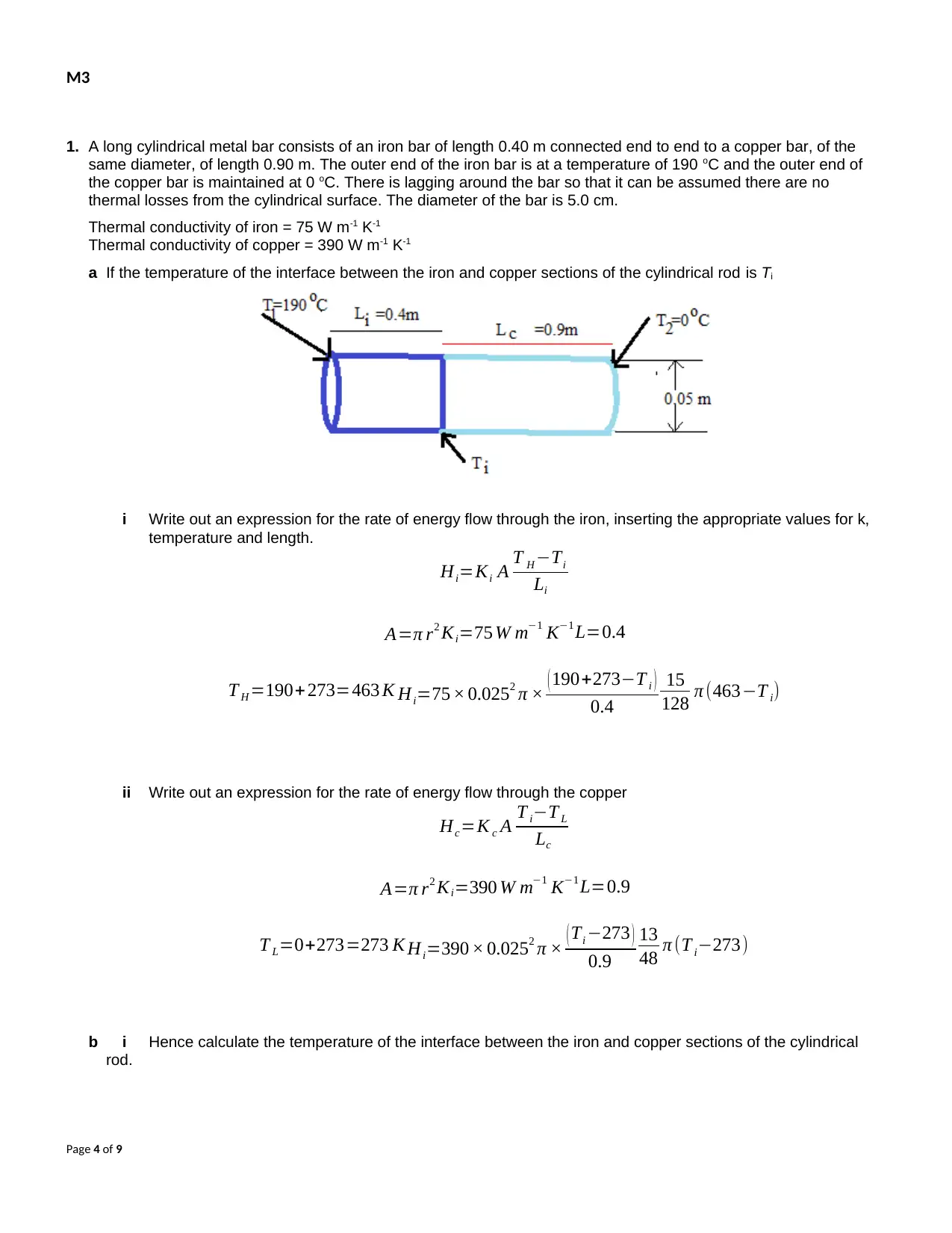
M3
1. A long cylindrical metal bar consists of an iron bar of length 0.40 m connected end to end to a copper bar, of the
same diameter, of length 0.90 m. The outer end of the iron bar is at a temperature of 190 oC and the outer end of
the copper bar is maintained at 0 oC. There is lagging around the bar so that it can be assumed there are no
thermal losses from the cylindrical surface. The diameter of the bar is 5.0 cm.
Thermal conductivity of iron = 75 W m-1 K-1
Thermal conductivity of copper = 390 W m-1 K-1
a If the temperature of the interface between the iron and copper sections of the cylindrical rod is Ti
i Write out an expression for the rate of energy flow through the iron, inserting the appropriate values for k,
temperature and length.
Hi=Ki A T H −Ti
Li
A=π r2 Ki=75 W m−1 K−1 L=0.4
T H =190+ 273=463 K Hi=75 × 0.0252 π × ( 190+273−T i )
0.4
15
128 π (463−T i)
ii Write out an expression for the rate of energy flow through the copper
Hc=K c A T i−T L
Lc
A=π r2 Ki=390 W m−1 K−1 L=0.9
T L=0+273=273 K Hi=390 × 0.0252 π × ( Ti −273 )
0.9
13
48 π (T i−273)
b i Hence calculate the temperature of the interface between the iron and copper sections of the cylindrical
rod.
Page 4 of 9
1. A long cylindrical metal bar consists of an iron bar of length 0.40 m connected end to end to a copper bar, of the
same diameter, of length 0.90 m. The outer end of the iron bar is at a temperature of 190 oC and the outer end of
the copper bar is maintained at 0 oC. There is lagging around the bar so that it can be assumed there are no
thermal losses from the cylindrical surface. The diameter of the bar is 5.0 cm.
Thermal conductivity of iron = 75 W m-1 K-1
Thermal conductivity of copper = 390 W m-1 K-1
a If the temperature of the interface between the iron and copper sections of the cylindrical rod is Ti
i Write out an expression for the rate of energy flow through the iron, inserting the appropriate values for k,
temperature and length.
Hi=Ki A T H −Ti
Li
A=π r2 Ki=75 W m−1 K−1 L=0.4
T H =190+ 273=463 K Hi=75 × 0.0252 π × ( 190+273−T i )
0.4
15
128 π (463−T i)
ii Write out an expression for the rate of energy flow through the copper
Hc=K c A T i−T L
Lc
A=π r2 Ki=390 W m−1 K−1 L=0.9
T L=0+273=273 K Hi=390 × 0.0252 π × ( Ti −273 )
0.9
13
48 π (T i−273)
b i Hence calculate the temperature of the interface between the iron and copper sections of the cylindrical
rod.
Page 4 of 9
Paraphrase This Document
Need a fresh take? Get an instant paraphrase of this document with our AI Paraphraser
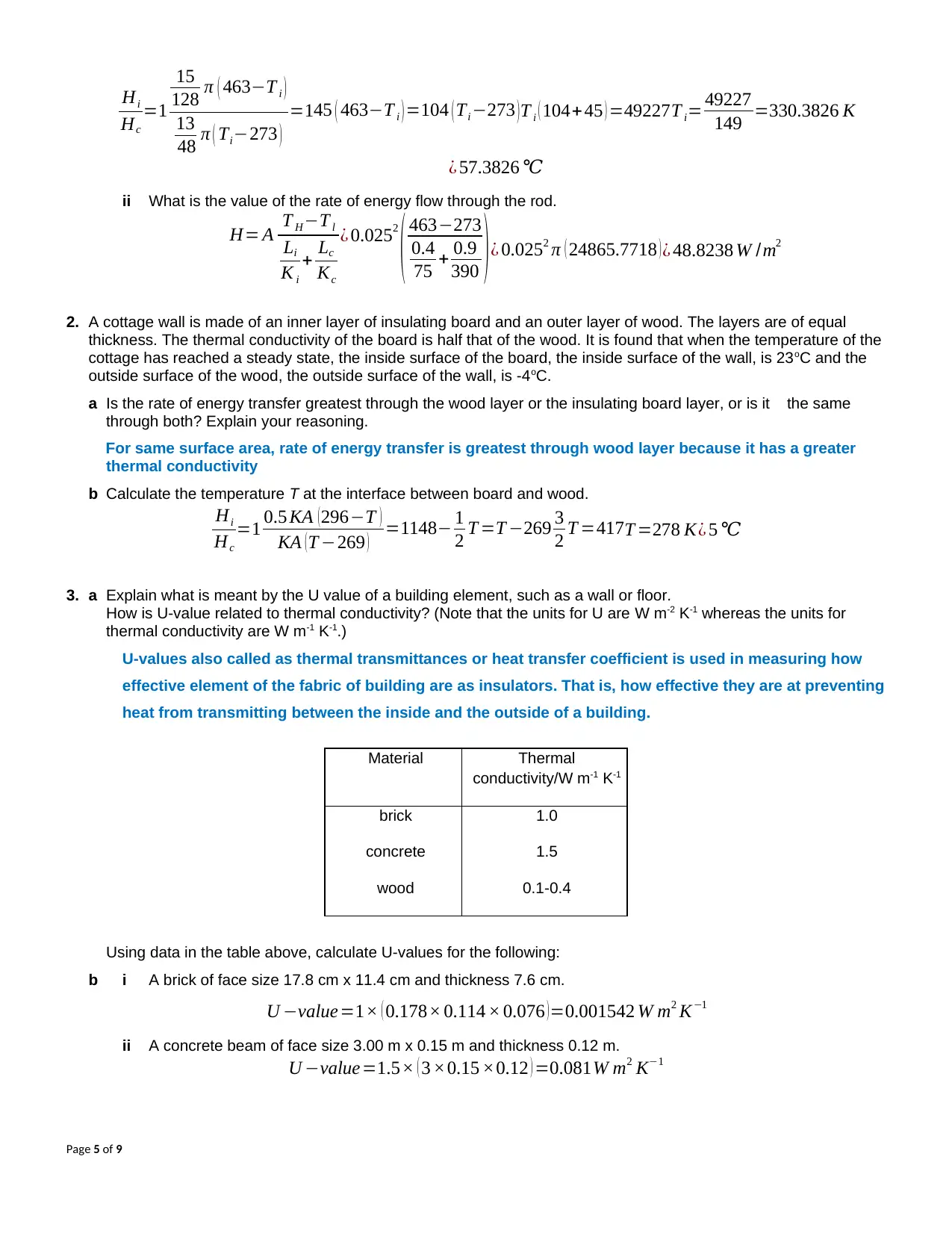
Hi
Hc
=1
15
128 π ( 463−T i )
13
48 π ( Ti−273 )
=145 ( 463−T i ) =104 ( Ti −273 ) T i ( 104+ 45 ) =49227T i= 49227
149 =330.3826 K
¿ 57.3826 ℃
ii What is the value of the rate of energy flow through the rod.
H= A T H −T l
Li
K i
+ Lc
Kc
¿ 0.0252
( 463−273
0.4
75 + 0.9
390 )¿ 0.0252 π ( 24865.7718 ) ¿ 48.8238 W /m2
2. A cottage wall is made of an inner layer of insulating board and an outer layer of wood. The layers are of equal
thickness. The thermal conductivity of the board is half that of the wood. It is found that when the temperature of the
cottage has reached a steady state, the inside surface of the board, the inside surface of the wall, is 23oC and the
outside surface of the wood, the outside surface of the wall, is -4oC.
a Is the rate of energy transfer greatest through the wood layer or the insulating board layer, or is it the same
through both? Explain your reasoning.
For same surface area, rate of energy transfer is greatest through wood layer because it has a greater
thermal conductivity
b Calculate the temperature T at the interface between board and wood.
Hi
Hc
=1 0.5 KA (296−T )
KA (T −269 ) =1148− 1
2 T =T −269 3
2 T =417 T =278 K¿ 5 ℃
3. a Explain what is meant by the U value of a building element, such as a wall or floor.
How is U-value related to thermal conductivity? (Note that the units for U are W m-2 K-1 whereas the units for
thermal conductivity are W m-1 K-1.)
U-values also called as thermal transmittances or heat transfer coefficient is used in measuring how
effective element of the fabric of building are as insulators. That is, how effective they are at preventing
heat from transmitting between the inside and the outside of a building.
Material Thermal
conductivity/W m-1 K-1
brick 1.0
concrete 1.5
wood 0.1-0.4
Using data in the table above, calculate U-values for the following:
b i A brick of face size 17.8 cm x 11.4 cm and thickness 7.6 cm.
U −value=1× ( 0.178× 0.114 × 0.076 )=0.001542 W m2 K−1
ii A concrete beam of face size 3.00 m x 0.15 m and thickness 0.12 m.
U −value=1.5× ( 3 ×0.15 ×0.12 ) =0.081W m2 K−1
Page 5 of 9
Hc
=1
15
128 π ( 463−T i )
13
48 π ( Ti−273 )
=145 ( 463−T i ) =104 ( Ti −273 ) T i ( 104+ 45 ) =49227T i= 49227
149 =330.3826 K
¿ 57.3826 ℃
ii What is the value of the rate of energy flow through the rod.
H= A T H −T l
Li
K i
+ Lc
Kc
¿ 0.0252
( 463−273
0.4
75 + 0.9
390 )¿ 0.0252 π ( 24865.7718 ) ¿ 48.8238 W /m2
2. A cottage wall is made of an inner layer of insulating board and an outer layer of wood. The layers are of equal
thickness. The thermal conductivity of the board is half that of the wood. It is found that when the temperature of the
cottage has reached a steady state, the inside surface of the board, the inside surface of the wall, is 23oC and the
outside surface of the wood, the outside surface of the wall, is -4oC.
a Is the rate of energy transfer greatest through the wood layer or the insulating board layer, or is it the same
through both? Explain your reasoning.
For same surface area, rate of energy transfer is greatest through wood layer because it has a greater
thermal conductivity
b Calculate the temperature T at the interface between board and wood.
Hi
Hc
=1 0.5 KA (296−T )
KA (T −269 ) =1148− 1
2 T =T −269 3
2 T =417 T =278 K¿ 5 ℃
3. a Explain what is meant by the U value of a building element, such as a wall or floor.
How is U-value related to thermal conductivity? (Note that the units for U are W m-2 K-1 whereas the units for
thermal conductivity are W m-1 K-1.)
U-values also called as thermal transmittances or heat transfer coefficient is used in measuring how
effective element of the fabric of building are as insulators. That is, how effective they are at preventing
heat from transmitting between the inside and the outside of a building.
Material Thermal
conductivity/W m-1 K-1
brick 1.0
concrete 1.5
wood 0.1-0.4
Using data in the table above, calculate U-values for the following:
b i A brick of face size 17.8 cm x 11.4 cm and thickness 7.6 cm.
U −value=1× ( 0.178× 0.114 × 0.076 )=0.001542 W m2 K−1
ii A concrete beam of face size 3.00 m x 0.15 m and thickness 0.12 m.
U −value=1.5× ( 3 ×0.15 ×0.12 ) =0.081W m2 K−1
Page 5 of 9

iii A wood panel of area 5.0 m x 3.5 m and thickness 8 mm (use an average value for thermal conductivity).
conductivity=0.25U −value=0.25× ( 5 ×3. 5× 0. 008 ) =0.035 W m2 K−1
Page 6 of 9
conductivity=0.25U −value=0.25× ( 5 ×3. 5× 0. 008 ) =0.035 W m2 K−1
Page 6 of 9
⊘ This is a preview!⊘
Do you want full access?
Subscribe today to unlock all pages.

Trusted by 1+ million students worldwide
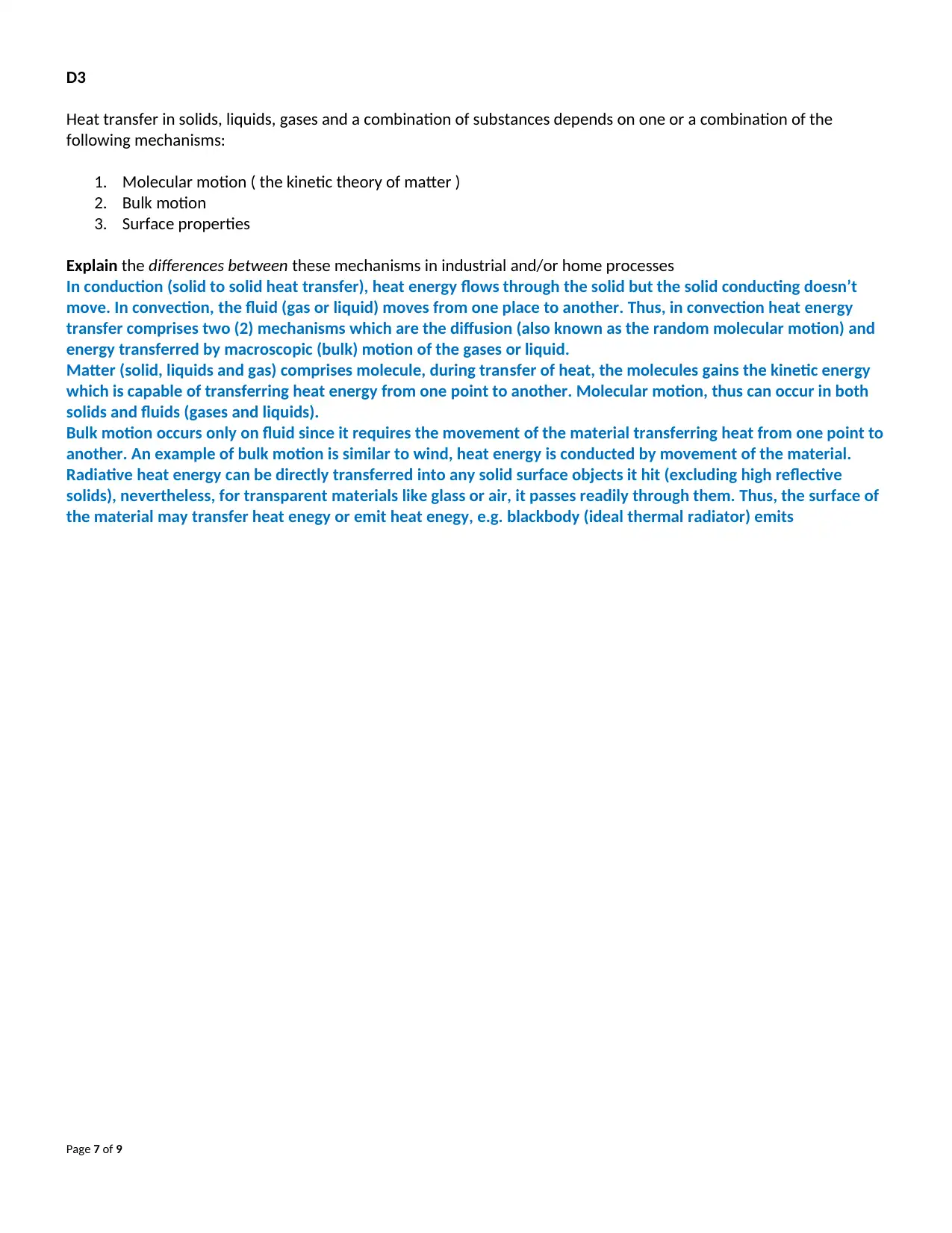
D3
Heat transfer in solids, liquids, gases and a combination of substances depends on one or a combination of the
following mechanisms:
1. Molecular motion ( the kinetic theory of matter )
2. Bulk motion
3. Surface properties
Explain the differences between these mechanisms in industrial and/or home processes
In conduction (solid to solid heat transfer), heat energy flows through the solid but the solid conducting doesn’t
move. In convection, the fluid (gas or liquid) moves from one place to another. Thus, in convection heat energy
transfer comprises two (2) mechanisms which are the diffusion (also known as the random molecular motion) and
energy transferred by macroscopic (bulk) motion of the gases or liquid.
Matter (solid, liquids and gas) comprises molecule, during transfer of heat, the molecules gains the kinetic energy
which is capable of transferring heat energy from one point to another. Molecular motion, thus can occur in both
solids and fluids (gases and liquids).
Bulk motion occurs only on fluid since it requires the movement of the material transferring heat from one point to
another. An example of bulk motion is similar to wind, heat energy is conducted by movement of the material.
Radiative heat energy can be directly transferred into any solid surface objects it hit (excluding high reflective
solids), nevertheless, for transparent materials like glass or air, it passes readily through them. Thus, the surface of
the material may transfer heat enegy or emit heat enegy, e.g. blackbody (ideal thermal radiator) emits
Page 7 of 9
Heat transfer in solids, liquids, gases and a combination of substances depends on one or a combination of the
following mechanisms:
1. Molecular motion ( the kinetic theory of matter )
2. Bulk motion
3. Surface properties
Explain the differences between these mechanisms in industrial and/or home processes
In conduction (solid to solid heat transfer), heat energy flows through the solid but the solid conducting doesn’t
move. In convection, the fluid (gas or liquid) moves from one place to another. Thus, in convection heat energy
transfer comprises two (2) mechanisms which are the diffusion (also known as the random molecular motion) and
energy transferred by macroscopic (bulk) motion of the gases or liquid.
Matter (solid, liquids and gas) comprises molecule, during transfer of heat, the molecules gains the kinetic energy
which is capable of transferring heat energy from one point to another. Molecular motion, thus can occur in both
solids and fluids (gases and liquids).
Bulk motion occurs only on fluid since it requires the movement of the material transferring heat from one point to
another. An example of bulk motion is similar to wind, heat energy is conducted by movement of the material.
Radiative heat energy can be directly transferred into any solid surface objects it hit (excluding high reflective
solids), nevertheless, for transparent materials like glass or air, it passes readily through them. Thus, the surface of
the material may transfer heat enegy or emit heat enegy, e.g. blackbody (ideal thermal radiator) emits
Page 7 of 9
Paraphrase This Document
Need a fresh take? Get an instant paraphrase of this document with our AI Paraphraser
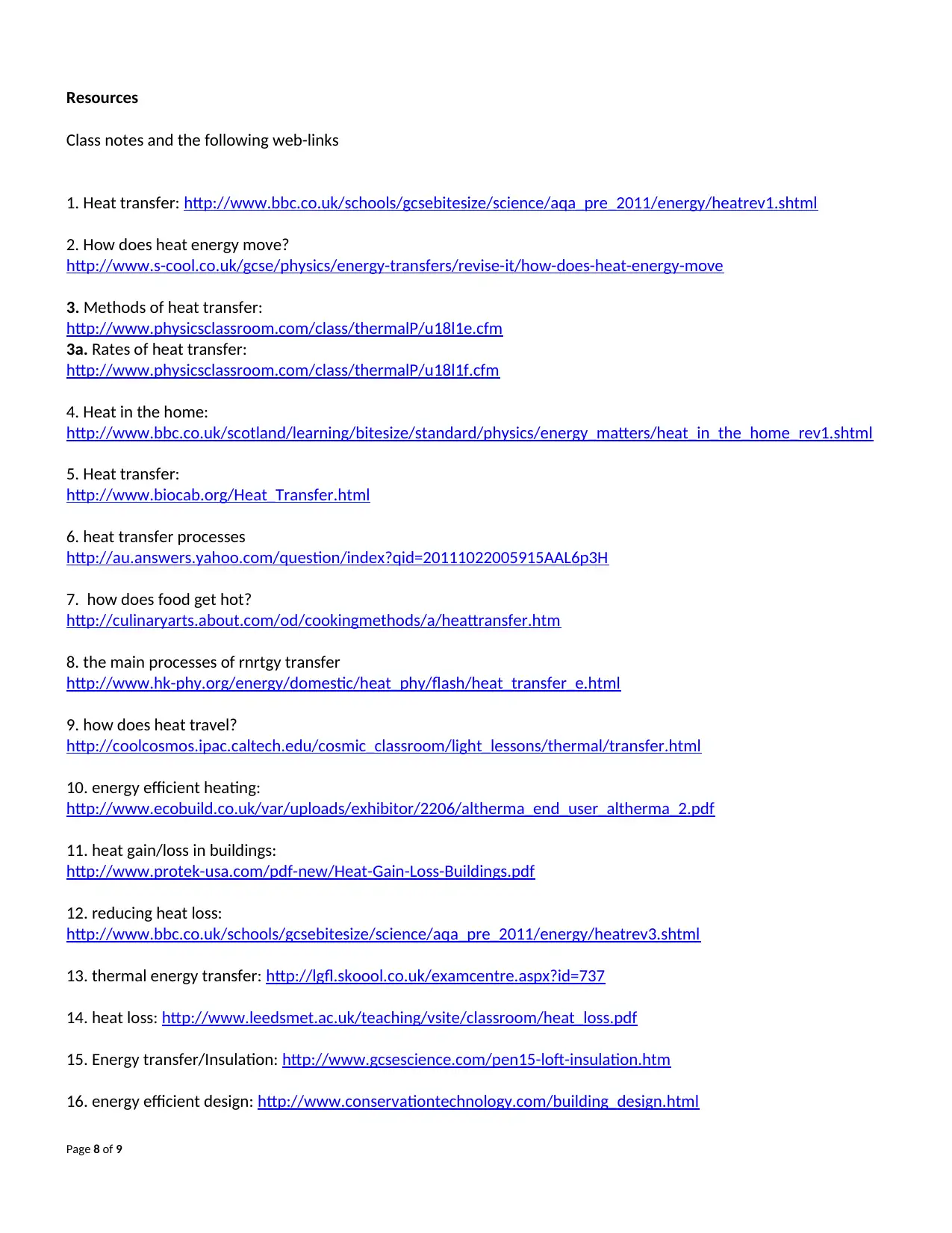
Resources
Class notes and the following web-links
1. Heat transfer: http://www.bbc.co.uk/schools/gcsebitesize/science/aqa_pre_2011/energy/heatrev1.shtml
2. How does heat energy move?
http://www.s-cool.co.uk/gcse/physics/energy-transfers/revise-it/how-does-heat-energy-move
3. Methods of heat transfer:
http://www.physicsclassroom.com/class/thermalP/u18l1e.cfm
3a. Rates of heat transfer:
http://www.physicsclassroom.com/class/thermalP/u18l1f.cfm
4. Heat in the home:
http://www.bbc.co.uk/scotland/learning/bitesize/standard/physics/energy_matters/heat_in_the_home_rev1.shtml
5. Heat transfer:
http://www.biocab.org/Heat_Transfer.html
6. heat transfer processes
http://au.answers.yahoo.com/question/index?qid=20111022005915AAL6p3H
7. how does food get hot?
http://culinaryarts.about.com/od/cookingmethods/a/heattransfer.htm
8. the main processes of rnrtgy transfer
http://www.hk-phy.org/energy/domestic/heat_phy/flash/heat_transfer_e.html
9. how does heat travel?
http://coolcosmos.ipac.caltech.edu/cosmic_classroom/light_lessons/thermal/transfer.html
10. energy efficient heating:
http://www.ecobuild.co.uk/var/uploads/exhibitor/2206/altherma_end_user_altherma_2.pdf
11. heat gain/loss in buildings:
http://www.protek-usa.com/pdf-new/Heat-Gain-Loss-Buildings.pdf
12. reducing heat loss:
http://www.bbc.co.uk/schools/gcsebitesize/science/aqa_pre_2011/energy/heatrev3.shtml
13. thermal energy transfer: http://lgfl.skoool.co.uk/examcentre.aspx?id=737
14. heat loss: http://www.leedsmet.ac.uk/teaching/vsite/classroom/heat_loss.pdf
15. Energy transfer/Insulation: http://www.gcsescience.com/pen15-loft-insulation.htm
16. energy efficient design: http://www.conservationtechnology.com/building_design.html
Page 8 of 9
Class notes and the following web-links
1. Heat transfer: http://www.bbc.co.uk/schools/gcsebitesize/science/aqa_pre_2011/energy/heatrev1.shtml
2. How does heat energy move?
http://www.s-cool.co.uk/gcse/physics/energy-transfers/revise-it/how-does-heat-energy-move
3. Methods of heat transfer:
http://www.physicsclassroom.com/class/thermalP/u18l1e.cfm
3a. Rates of heat transfer:
http://www.physicsclassroom.com/class/thermalP/u18l1f.cfm
4. Heat in the home:
http://www.bbc.co.uk/scotland/learning/bitesize/standard/physics/energy_matters/heat_in_the_home_rev1.shtml
5. Heat transfer:
http://www.biocab.org/Heat_Transfer.html
6. heat transfer processes
http://au.answers.yahoo.com/question/index?qid=20111022005915AAL6p3H
7. how does food get hot?
http://culinaryarts.about.com/od/cookingmethods/a/heattransfer.htm
8. the main processes of rnrtgy transfer
http://www.hk-phy.org/energy/domestic/heat_phy/flash/heat_transfer_e.html
9. how does heat travel?
http://coolcosmos.ipac.caltech.edu/cosmic_classroom/light_lessons/thermal/transfer.html
10. energy efficient heating:
http://www.ecobuild.co.uk/var/uploads/exhibitor/2206/altherma_end_user_altherma_2.pdf
11. heat gain/loss in buildings:
http://www.protek-usa.com/pdf-new/Heat-Gain-Loss-Buildings.pdf
12. reducing heat loss:
http://www.bbc.co.uk/schools/gcsebitesize/science/aqa_pre_2011/energy/heatrev3.shtml
13. thermal energy transfer: http://lgfl.skoool.co.uk/examcentre.aspx?id=737
14. heat loss: http://www.leedsmet.ac.uk/teaching/vsite/classroom/heat_loss.pdf
15. Energy transfer/Insulation: http://www.gcsescience.com/pen15-loft-insulation.htm
16. energy efficient design: http://www.conservationtechnology.com/building_design.html
Page 8 of 9

Page 9 of 9
⊘ This is a preview!⊘
Do you want full access?
Subscribe today to unlock all pages.

Trusted by 1+ million students worldwide
1 out of 9
Related Documents
Your All-in-One AI-Powered Toolkit for Academic Success.
+13062052269
info@desklib.com
Available 24*7 on WhatsApp / Email
![[object Object]](/_next/static/media/star-bottom.7253800d.svg)
Unlock your academic potential
Copyright © 2020–2025 A2Z Services. All Rights Reserved. Developed and managed by ZUCOL.



